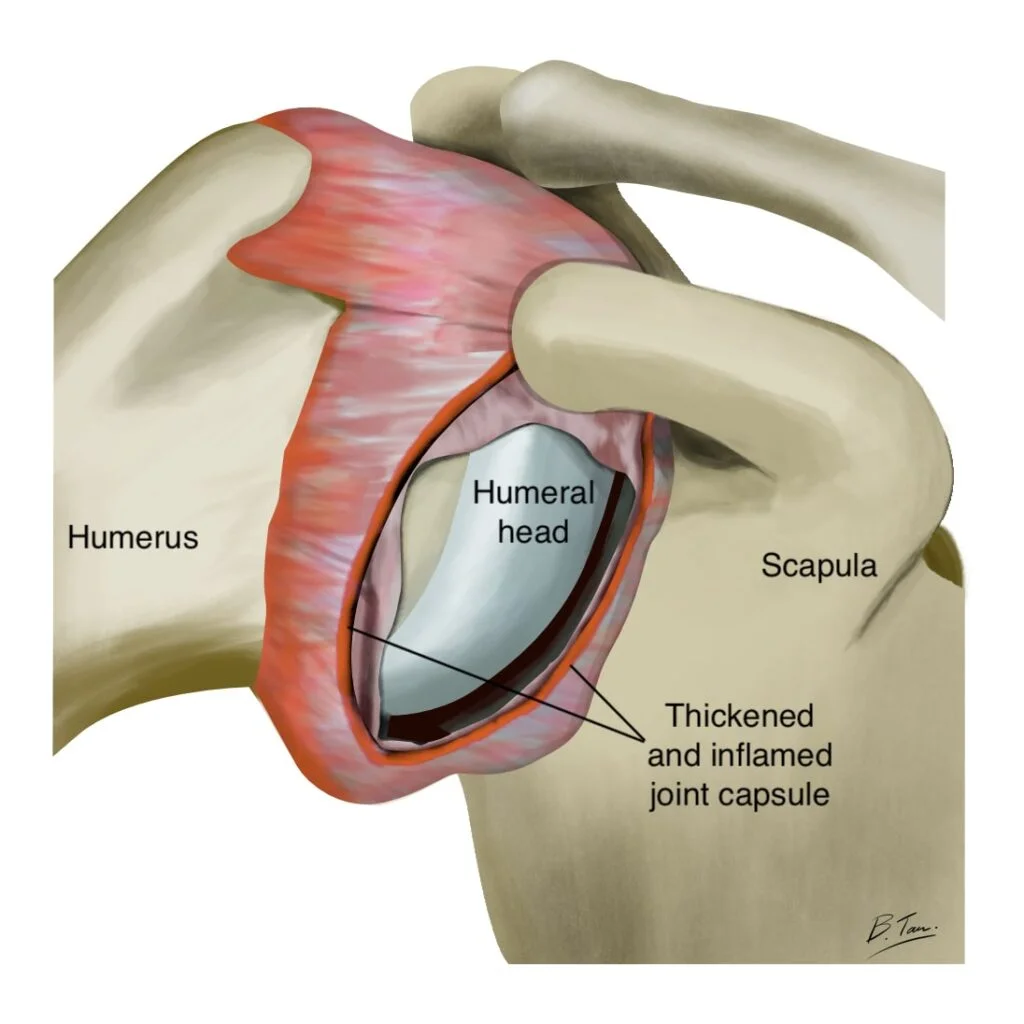Frozen shoulder, medically referred to as adhesive capsulitis, is a condition marked by stiffness, pain, and restricted movement in the shoulder joint. This condition develops gradually and progresses through distinct stages, potentially lasting between 1 to 3 years.
The condition commonly arises when the shoulder is immobilized for a long period — such as after surgery, injury, or fracture. Lack of movement can cause the capsule of connective tissue surrounding the joint to become inflamed and tight, significantly reducing mobility.
While most cases improve with non-surgical treatments such as stretching exercises and physical therapy, some may require injections (corticosteroids or anesthetics) to manage inflammation and discomfort. In rare instances, arthroscopic surgery may be recommended to release the tightened joint capsule.
Frozen shoulder typically affects only one shoulder at a time, and recurrence in the same shoulder is rare. However, it can develop in the opposite shoulder — usually within five years of the first episode.
Common Symptoms of Frozen Shoulder
Frozen shoulder progresses through three distinct phases, each with its own set of symptoms:
1. Freezing Stage
- Gradual onset of pain whenever the shoulder is moved.
- Increasing restriction in range of motion.
- Pain may intensify at night, potentially disturbing sleep.
- This stage can last anywhere from 2 to 9 months.
2. Frozen Stage
- Pain may begin to subside during this phase.
- Stiffness becomes the dominant issue.
- Daily activities involving shoulder movement become more difficult.
- This phase usually lasts between 4 to 12 months.
3. Thawing Stage
- Gradual improvement in the shoulder’s ability to move.
- Pain continues to decrease.
- Normal range of motion slowly returns.
- Recovery in this stage can take 5 to 24 months.
Not all individuals experience these stages in the same way, and the duration may vary from person to person.
What Causes Frozen Shoulder?
The shoulder joint is surrounded by a capsule of connective tissue that holds everything in place. In frozen shoulder, this capsule becomes inflamed, thickens, and tightens, leading to reduced movement and pain.
While the precise cause is not always clear, this condition frequently develops following a period of shoulder immobility — such as during recovery from an injury, surgery, or illness that restricts movement.
ALSO VISIT
Who Is at Risk for Developing Frozen Shoulder?
Several factors may contribute to the likelihood of developing frozen shoulder:
1. Age and Gender
- Most common among people between the ages of 40 and 60.
- Women are more frequently affected than men.
2. Limited Shoulder Movement
Prolonged shoulder immobility significantly raises the risk. This may result from:
- Rotator cuff injuries
- Arm fractures
- Post-operative recovery
- Stroke, which can impair shoulder mobility
3. Underlying Health Conditions
Certain systemic diseases may predispose individuals to frozen shoulder, including:
- Diabetes mellitus (a major risk factor)
- Hyperthyroidism (overactive thyroid)
- Hypothyroidism (underactive thyroid)
- Cardiovascular disease
- Parkinson’s disease
How to Prevent Frozen Shoulder
Preventing frozen shoulder often involves keeping the shoulder moving, even after injury or surgery. Individuals recovering from conditions that limit shoulder use — such as fractures or strokes — should consult healthcare professionals about gentle movement or physical therapy exercises to maintain joint flexibility.
Early intervention and guided rehabilitation programs can significantly reduce the risk of developing adhesive capsulitis during periods of restricted mobility.
: Frozen Shoulder Treatment Options That Work
While frozen shoulder usually improves over time, treatment focuses on pain relief and restoring movement:
1. Physical Therapy
- Targeted exercises to improve shoulder flexibility and strength.
- Stretching and mobility drills are essential during all stages.
2. Medications and Injections
- Over-the-counter pain relievers like ibuprofen or acetaminophen.
- Corticosteroid injections may reduce inflammation and alleviate pain.
- Joint lubricants or anesthetic injections might be used to ease stiffness.
3. Surgical Intervention (if needed)
- In persistent or severe cases, arthroscopic surgery may be performed to release tight tissue in the joint capsule.
- Shoulder manipulation under anesthesia is another method, where the joint is forcefully moved while the patient is unconscious to break adhesions.
Conclusion
Frozen shoulder is a manageable, though often slow-healing, condition. Understanding its phases, causes, and risk factors can help in early recognition and timely intervention. Keeping the shoulder joint mobile — especially after injury or surgery — plays a crucial role in both prevention and recovery.
If you suspect you may have symptoms of frozen shoulder, it’s important to seek advice from a healthcare provider. Early diagnosis and treatment can significantly shorten recovery time and reduce discomfort.
